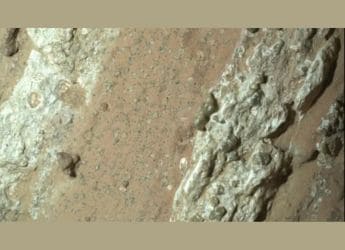- Home
- Science
- Science News
- ESA's Mars Express Sends New Images of Martian Landscape
ESA's Mars Express Sends New Images of Martian Landscape

The European Space Agency's (ESA) Mars Express has imaged a part of the Martian landscape, a region at the boundary of the northern and southern hemisphere which is rocky and fragmented, that once formed the Red Planet's flood plains.
The region, a furrowed, rock-filled escarpment known as Nili Fossae sits at the boundary of the northern and southern hemisphere.
It is an impressive example of past activity on the planet and shows signs of where flowing wind, water and ice once moved material from place to place, carving out distinctive patterns and landforms as it did so, the ESA said in a statement on Wednesday.
Despite Mars' reputation as a dry, arid world today, water is believed to have played a key role in sculpting Nili Fossae via ongoing erosion.
Nili Fossae is filled with rocky valleys, small hills, and clusters of flat-topped landforms (known as mesas in geological terms), with some chunks of crustal rock appearing to be depressed down into the surface creating a number of ditch-like features known as graben, the ESA noted.
Further, the image also showed the higher-altitude terrain of Nili Fossae. This appears to consist mostly of rocky plateaus while the lower terrain comprises of smaller rocks, mesas, hills and more, with the two sections roughly separated by erosion channels and valleys.
The shapes and structures scattered throughout this image are thought to have been shaped over time by flows of not only water and ice, but also wind, ESA said.
The images showed patches of the surface that appear to be notably dark against the ochre background, as if smudged with charcoal or ink.
These are areas of darker volcanic sand, which have been transported and deposited by present-day martian winds. Wind moves sand and dust around often on Mars' surface, creating rippling dune fields across the planet and forming multi-coloured, patchy terrain like Nili Fossae, the researchers said.
The data comprising this image was gathered by Mars Express' High Resolution Stereo Camera (HRSC) on February 26.
Get your daily dose of tech news, reviews, and insights, in under 80 characters on Gadgets 360 Turbo. Connect with fellow tech lovers on our Forum. Follow us on X, Facebook, WhatsApp, Threads and Google News for instant updates. Catch all the action on our YouTube channel.
Related Stories
- Samsung Galaxy Unpacked 2025
- ChatGPT
- Redmi Note 14 Pro+
- iPhone 16
- Apple Vision Pro
- Oneplus 12
- OnePlus Nord CE 3 Lite 5G
- iPhone 13
- Xiaomi 14 Pro
- Oppo Find N3
- Tecno Spark Go (2023)
- Realme V30
- Best Phones Under 25000
- Samsung Galaxy S24 Series
- Cryptocurrency
- iQoo 12
- Samsung Galaxy S24 Ultra
- Giottus
- Samsung Galaxy Z Flip 5
- Apple 'Scary Fast'
- Housefull 5
- GoPro Hero 12 Black Review
- Invincible Season 2
- JioGlass
- HD Ready TV
- Laptop Under 50000
- Smartwatch Under 10000
- Latest Mobile Phones
- Compare Phones
- Honor Win RT
- Honor Win
- Xiaomi 17 Ultra Leica Edition
- Xiaomi 17 Ultra
- Huawei Nova 15
- Huawei Nova 15 Pro
- Huawei Nova 15 Ultra
- OnePlus 15R
- Asus ProArt P16
- MacBook Pro 14-inch (M5, 2025)
- OPPO Pad Air 5
- Huawei MatePad 11.5 (2026)
- Xiaomi Watch 5
- Huawei Watch 10th Anniversary Edition
- Acerpure Nitro Z Series 100-inch QLED TV
- Samsung 43 Inch LED Ultra HD (4K) Smart TV (UA43UE81AFULXL)
- Asus ROG Ally
- Nintendo Switch Lite
- Haier 1.6 Ton 5 Star Inverter Split AC (HSU19G-MZAID5BN-INV)
- Haier 1.6 Ton 5 Star Inverter Split AC (HSU19G-MZAIM5BN-INV)

















